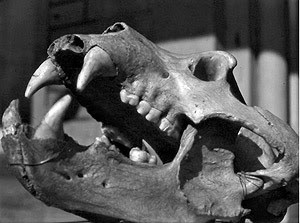The modern history of the place goes back to 1837, when a couple of local lads out for a stroll had their dog go missing. It seems the hound had crawled down a small hole, probably in pursuit of small game. He found a lot more.
Prying away rocks that were blocking the entrance a cave was entered, one in which Romano-British artifacts were lying about on the surface. Excavations went on at a leisurely pace for a few years, with the cave being named Victoria after the coronation of same in 1838. But it turns out there was a lot more waiting deeper down.
Ongoing excavations soon turned up deeper layers where implements of neolithic man and the skeletons of now extinct animals were found. The bones of giant deer, hippopotamuses, and straight tusked elephants turned up, many of them seemingly hauled in by giant hyenas in the period between Ice Ages some 130,000 years ago.
 |
| The 1870's excavation site |
But after The Great War, a local with the fabulous name of Tot Lord resumed excavation of Victoria and nearby caves with a band of amateurs who went by the moniker The Pig Yard Club. Through their efforts and with the benefit of more modern archaeological techniques, the long history of Victoria Cave has been more accurately defined. For instance carbon dating of the earliest artifacts suggests that humans were here circa 12,000 BC, the earliest such evidence in Yorkshire.
Another bit of modern flourish to old archaeology can be seen in these digital 3D images of the initial Roman era finds:
3D Romano-British artifacts from Victoria Cave
As one with an abiding interest in the Roman aspects of this excavation I was able to locate an on line account of the excavations dated 1872. It adds some helpful details, such as the fact that the coins from the site are a couple of early ones from Trajan and a larger number of late Imperial issues and Barbarous Radiates from the declining days of Roman power. In true British Imperial fashion this report goes way out on a limb regarding its conclusions that the people who left these artifacts were refugees from barbarian assaults.
Here's the inside of the cave. The notion that there are still important archaeological layers here after so many years of excavation by farmers, antiquarians and Pig Yard Club members is a bit dubious, but good manners alone was enough to keep me on the proper side of the barrier.




1 comment:
Interesting!
Post a Comment